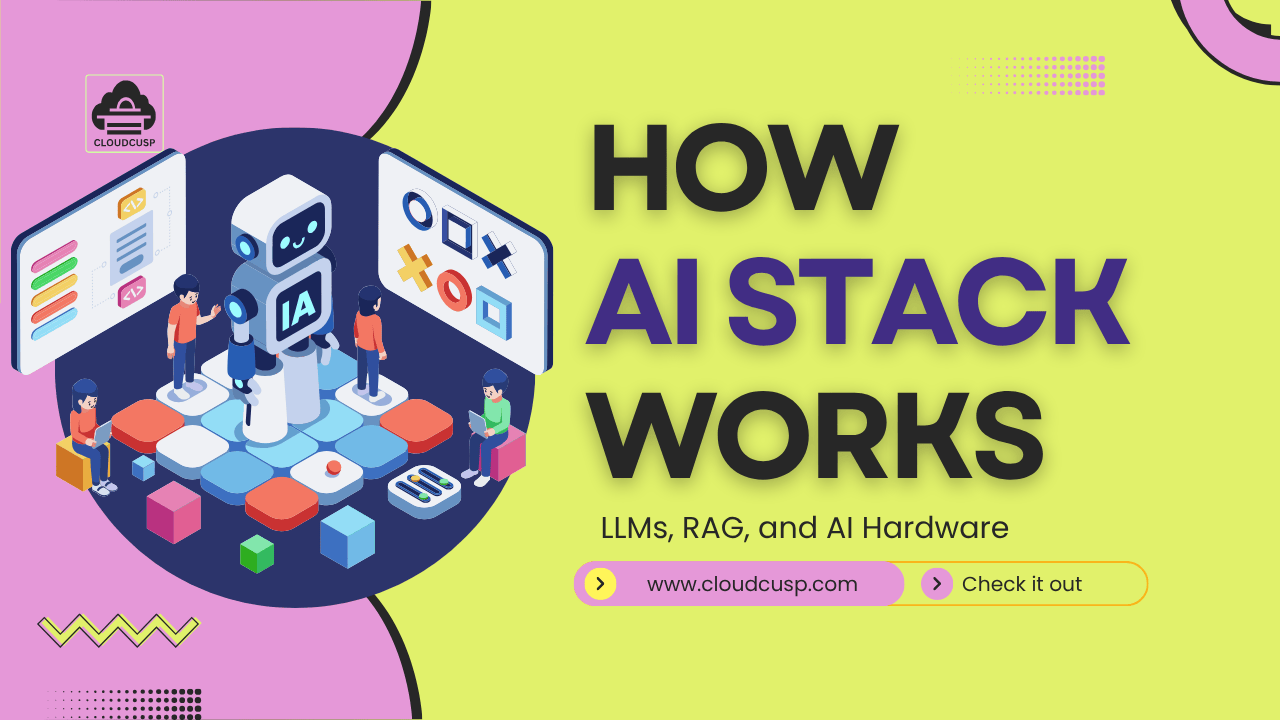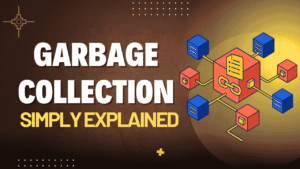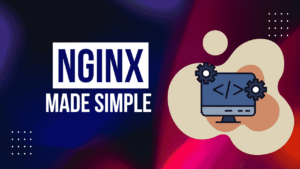Key Takeaways
- Large Language Models (LLMs) are the foundation of modern AI applications, capable of understanding and generating human-like text.
- Retrieval-Augmented Generation (RAG) enhances LLMs by combining them with external knowledge bases, improving accuracy and reducing hallucinations.
- AI Hardware (GPUs, TPUs, etc.) is essential for training and running AI models efficiently, with specialized chips revolutionizing the field.
- The integration of these components creates a powerful AI Stack that enables sophisticated applications across industries.
- Understanding the interconnections between LLMs, RAG, and hardware is crucial for building effective AI solutions.
On This Page
Table of Contents
The term AI Stack refers to the collection of technologies, frameworks, and infrastructure that work together to create and deploy artificial intelligence applications. Think of it as a layered architecture where each component builds upon the others to create powerful AI systems.
The modern AI Stack consists of three key elements: Large Language Models (LLMs), Retrieval-Augmented Generation (RAG), and AI Hardware. These components work in harmony to enable the AI applications we interact with daily, from chatbots to content creation tools.
Understanding how these elements fit together is essential for anyone interested in AI development, implementation, or even just curious about how the technology behind tools like ChatGPT works. In this page, we’ll explore each component in detail, explaining how they function independently and as part of the larger AI ecosystem.
Large Language Models (LLMs)
What are LLMs?
Large Language Models (LLMs) are advanced AI systems designed to understand, process, and generate human-like text. These models are “large” not just in their capabilities but in their architecture, containing billions of parameters that enable them to recognize patterns in language.

Imagine an LLM as a highly advanced autocomplete system that has read vast portions of the internet. Just as your phone suggests the next word when you’re typing, LLMs can predict and generate entire paragraphs, essays, or even code based on the input they receive.
How do LLMs work?
LLMs operate on a principle called transformer architecture, which allows them to process text in context. Here’s a simplified breakdown:
- Training Phase: LLMs are trained on enormous datasets containing text from books, websites, articles, and more.
- Pattern Recognition: During training, the model learns patterns, grammar, facts, and even some reasoning abilities.
- Prediction: When given input, the model predicts the most likely sequence of words to follow.
The magic happens through neural networks with multiple layers of transformers. These transformers use a mechanism called attention to weigh the importance of different words in the input when generating output.
For example, when asked “What is the capital of France?”, the model’s attention mechanism focuses on “capital” and “France” to generate “Paris” as the answer.
Popular LLMs
Several LLMs have gained prominence in recent years. Here’s a comparison of some of the most notable ones:
| Model | Developer | Parameters | Key Features |
|---|---|---|---|
| GPT-4 | OpenAI | ~1.76 trillion | Multimodal, strong reasoning |
| Claude 3 | Anthropic | Unknown | Large context window, reduced bias |
| Llama 3 | Meta | 8B, 70B, 405B | Open-source, efficient |
| Gemini | Unknown | Multimodal, integrated with Google services |
Each model has its strengths and weaknesses, making them suitable for different applications. For instance, GPT-4 excels in creative tasks, while Claude 3 is known for its large context window and reduced bias.
Applications of LLMs
LLMs have found applications across numerous industries:
- Content Creation: Writing articles, marketing copy, and creative content
- Customer Service: Powering chatbots and virtual assistants
- Code Generation: Writing and debugging code for developers
- Research: Summarizing papers and extracting insights
- Education: Creating personalized learning materials
For example, a company might use an LLM to create a customer service chatbot that can understand and respond to customer queries without human intervention. This reduces costs and provides 24/7 support.
Limitations and challenges
Despite their impressive capabilities, LLMs face several challenges:
- Hallucinations: Sometimes generating incorrect or fabricated information
- Knowledge Cutoffs: Limited to information available up to their training date
- Bias: Reflecting biases present in their training data
- Resource Intensive: Requiring significant computational power for training and operation
These limitations have led to the development of complementary technologies like RAG, which we’ll explore next.
Retrieval-Augmented Generation (RAG)
What is RAG?
Retrieval-Augmented Generation (RAG) is an approach that enhances LLMs by combining them with external knowledge retrieval systems. Instead of relying solely on their pre-trained knowledge, RAG-enabled models can access and incorporate up-to-date information from external sources.
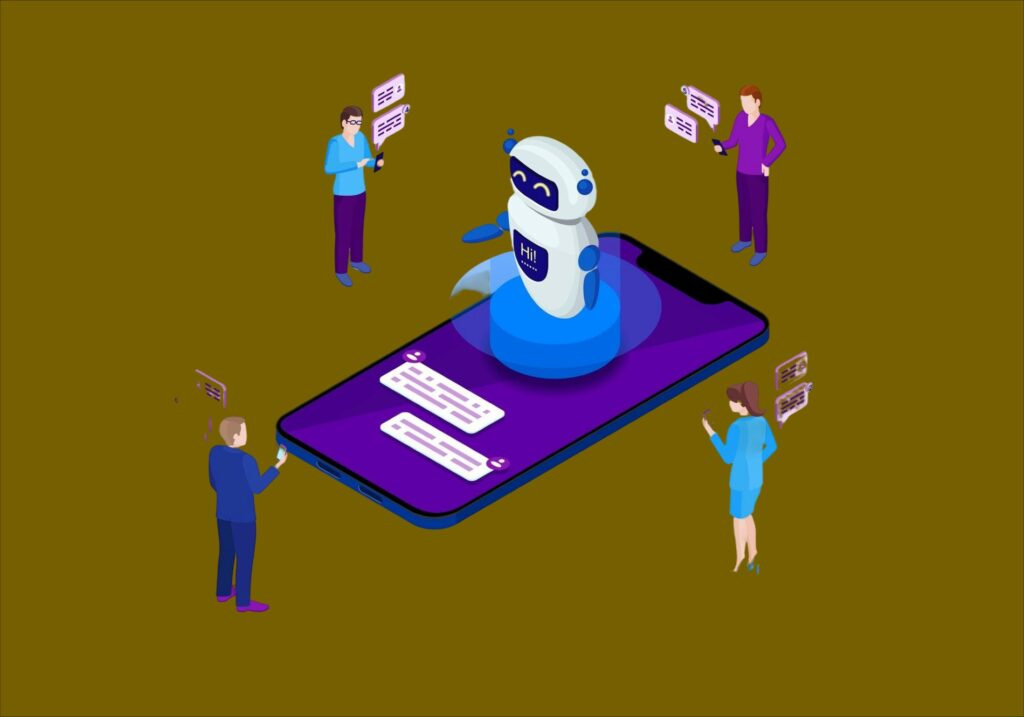
Think of RAG as giving an LLM a library it can reference before answering questions. Just as you might look up information in a book before giving a detailed answer, RAG allows models to retrieve relevant information to supplement their responses.
How does RAG work?
RAG operates through a two-step process:
- Retrieval: When a query is received, the system searches a knowledge base for relevant information.
- Generation: The retrieved information is then provided to the LLM along with the original query, guiding its response.
Here’s a simplified flow:
User Query → Retrieval System → Relevant Documents → LLM → Enhanced ResponseFor example, if you ask a RAG-enabled system about recent scientific discoveries, it would first search for the latest research papers or articles on the topic, then use that information to generate an up-to-date answer.
Benefits of RAG
RAG offers several advantages over standalone LLMs:
- Up-to-date Information: Access to current data beyond the model’s training cutoff
- Reduced Hallucinations: Grounding responses in factual, retrieved information
- Transparency: Ability to cite sources for verification
- Domain Specialization: Incorporating specialized knowledge without retraining the entire model
- Cost Efficiency: Updating knowledge bases is cheaper than retraining large models
RAG implementation
Implementing a RAG system involves several components:
- Knowledge Base: A collection of documents or data to retrieve from
- Embedding Model: Converts text into numerical representations
- Vector Database: Stores and efficiently searches embeddings
- Retrieval System: Finds relevant information based on query
- LLM: Generates responses using retrieved information
Here’s a simplified Python example of how a RAG system might be implemented:
from langchain.vectorstores import FAISS
from langchain.embeddings import OpenAIEmbeddings
from langchain.text_splitter import CharacterTextSplitter
from langchain.llms import OpenAI
from langchain.chains import RetrievalQA
# Load documents
documents = load_documents("knowledge_base")
# Split documents into chunks
text_splitter = CharacterTextSplitter(chunk_size=1000, chunk_overlap=0)
texts = text_splitter.split_documents(documents)
# Create embeddings
embeddings = OpenAIEmbeddings()
# Create vector store
vectorstore = FAISS.from_documents(texts, embeddings)
# Create RAG chain
qa_chain = RetrievalQA.from_chain_type(
llm=OpenAI(),
chain_type="stuff",
retriever=vectorstore.as_retriever()
)
# Query the system
result = qa_chain.run("What are the latest developments in quantum computing?")
print(result)This example demonstrates how documents can be embedded, stored in a vector database, and retrieved to enhance LLM responses.
Use cases
RAG has proven valuable in numerous applications:
- Customer Support: Accessing product documentation to answer specific questions
- Research Assistants: Retrieving and summarizing academic papers
- Legal Services: Searching case law and legal precedents
- Healthcare: Accessing medical literature for evidence-based responses
- Financial Analysis: Incorporating real-time market data into analysis
For instance, a financial institution might use RAG to create an AI assistant that can answer questions about market trends by retrieving the latest financial reports and news articles, ensuring the information is current and accurate.
AI Hardware
Importance of specialized hardware
The computational demands of training and running LLMs have led to the development of specialized AI Hardware. Traditional CPUs are inefficient for the massive parallel processing required by neural networks, necessitating hardware designed specifically for AI workloads.
Think of it like this: while a general-purpose tool like a Swiss Army knife is useful for many tasks, specialized tools like a chef’s knife perform specific tasks much more efficiently. Similarly, AI hardware is designed to excel at the mathematical operations central to machine learning.
Types of AI hardware
Several types of hardware have emerged to meet AI’s computational needs:
- Graphics Processing Units (GPUs)
- Originally designed for graphics rendering
- Excellent at parallel processing
- Widely used for both training and inference
- Tensor Processing Units (TPUs)
- Developed by Google specifically for neural networks
- Optimized for TensorFlow framework
- Highly efficient for large-scale training
- Field-Programmable Gate Arrays (FPGAs)
- Custom-designed for specific AI tasks
- Highly efficient but inflexible
- Examples include Google’s TPU and Tesla’s D1 chip
- Application-Specific Integrated Circuits (ASICs)
- Custom-designed for specific AI tasks
- Highly efficient but inflexible
- Examples include Google’s TPU and Tesla’s D1 chip
Here’s a comparison of these hardware types:
| Hardware Type | Flexibility | Performance | Energy Efficiency | Cost |
|---|---|---|---|---|
| GPU | High | High | Medium | High |
| TPU | Low | Very High | High | Very High |
| FPGA | Medium | Medium | High | Medium |
| ASIC | Very Low | Very High | Very High | Very High |
Key players in AI hardware
Several companies dominate the AI hardware landscape:
- NVIDIA: Leading GPU manufacturer with their A100 and H100 chips
- Google: Developer of TPUs used in their cloud services
- AMD: Competing with NVIDIA in the GPU market
- Intel: Developing AI-specific chips like the Gaudi series
- Apple: Creating neural engines for their devices
- Tesla: Designing chips for autonomous driving
These companies are in a constant race to develop more powerful and efficient hardware, as performance gains directly translate to better AI capabilities.
AI hardware Ahead
The future of AI hardware is focused on several key areas:
- Neuromorphic Computing: Hardware that mimics the brain’s structure
- Photonic Computing: Using light instead of electricity for computation
- Quantum Computing: Leveraging quantum mechanics for exponential speedups
- Edge AI: Developing efficient hardware for on-device AI processing
These advancements promise to make AI more powerful, efficient, and accessible in the coming years.
Integration of LLMs, RAG, and AI Hardware
How they work together
The true power of the AI Stack emerges when LLMs, RAG, and AI Hardware work in concert:
- AI Hardware provides the computational foundation, enabling the training and operation of large models.
- LLMs serve as the reasoning engine, capable of understanding and generating human-like text.
- RAG enhances LLMs with current, specific knowledge, overcoming their inherent limitations.
This integration creates systems that are both knowledgeable and adaptable, capable of handling a wide range of tasks with accuracy and relevance.
Best practices
When building an AI Stack, consider these best practices:
- Hardware Selection: Choose hardware based on your specific needs (training vs. inference, scale, etc.)
- Model Optimization: Optimize models for your target hardware to maximize efficiency
- Knowledge Base Curation: Regularly update and maintain your RAG knowledge base
- Monitoring: Implement systems to monitor performance and accuracy
- Scalability: Design your stack to scale with your needs
Challenges in integration
Integrating these components presents several challenges:
- Compatibility: Ensuring all components work together seamlessly
- Resource Management: Balancing computational resources across the stack
- Latency: Minimizing delays in retrieval and generation
- Cost: Managing the significant expenses associated with AI hardware and operations
- Expertise: Requiring specialized knowledge across multiple domains
Future Trends in AI Stack
The AI Stack is rapidly evolving, with several exciting trends on the horizon:
- Model Specialization: Development of smaller, specialized models for specific tasks
- Efficiency Improvements: Focus on creating more efficient models that require less computational power
- Multimodal Capabilities: Integrating text, image, audio, and video processing
- Edge Computing: Moving AI processing closer to users for reduced latency
- Democratization: Making AI tools more accessible to non-experts
These trends promise to make AI more powerful, efficient, and accessible in the coming years, further expanding its applications and impact.
WrapUP
The AI Stack, comprising LLMs, RAG, and AI Hardware, represents a revolutionary approach to artificial intelligence.
LLMs provide the foundation for understanding and generating human-like text, while RAG enhances these models with current, specific knowledge. AI Hardware makes it all possible by providing the computational power needed to train and run these systems.
The continued evolution of the AI Stack promises to unlock new capabilities and applications, transforming industries and creating new possibilities.
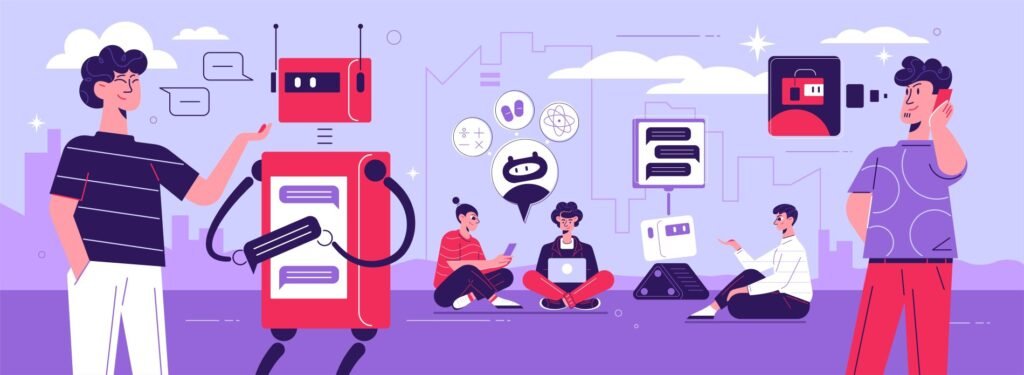
FAQ
What exactly is an AI Stack?
An AI Stack is like a team of technologies that work together to create smart applications. Think of it as a sandwich where each layer has a special job: the bottom layer is the AI Hardware (the computer brain), the middle is the LLMs (the language understanding part), and the top is RAG (the connection to current information). When these layers work together, they create AI systems that can understand questions and give helpful answers.
How do Large Language Models (LLMs) understand what I’m saying?
LLMs are like super-smart autocomplete systems that have read a huge portion of the internet. When you type something, they break it down into pieces they understand, look for patterns based on everything they’ve learned, and predict what words should come next. It’s similar to how your phone suggests the next word when you’re texting, but on a much bigger scale. They don’t “understand” like humans do – they’re just really good at recognizing patterns in language.
Why do AI systems sometimes make up information that isn’t true?
This happens because LLMs are designed to sound convincing, not necessarily to be accurate. Think of them like very confident storytellers who sometimes mix up facts. They’re working with patterns they’ve learned from their training data, and sometimes those patterns lead them to create plausible-sounding but incorrect information. This is why technologies like RAG are important – they help AI systems check their facts against reliable sources before answering.
What’s the difference between a regular search engine and RAG?
A search engine gives you a list of websites to look through yourself, while RAG (Retrieval-Augmented Generation) finds information and then uses it to create a direct answer. It’s like the difference between a librarian pointing you to books about your topic versus a helpful assistant who reads those books and summarizes the key points for you. RAG helps AI systems give more current and accurate answers by connecting them to up-to-date information.
Why can’t we just use regular computers for AI instead of special AI Hardware?
Regular computers are like general-purpose tools – they can do many things reasonably well. AI Hardware is like specialized tools designed specifically for the math that AI systems need. Think of trying to cut a steak with a butter knife – it works, but not efficiently. AI hardware has special parts that can do many calculations at once, which is exactly what AI needs. Using regular computers for AI would be incredibly slow and would use way too much electricity.
Can AI systems learn new things after they’ve been built?
Traditional LLMs have a hard time learning new things after their initial training – they’re like students who have finished reading all their textbooks but can’t add new pages. However, when combined with RAG, AI systems can access new information without being retrained. It’s like giving the student a library they can reference for the latest information. This is why many modern AI systems use RAG – it helps them stay current without needing expensive retraining.
How does AI Hardware affect the quality of AI applications?
Better AI Hardware allows for more powerful AI models that can understand more complex information and give better answers. It’s like the difference between a bicycle and a race car – both can get you somewhere, but the race car can go faster and handle more challenging conditions. Better hardware enables AI systems to process more information, learn from more examples, and respond more quickly to questions.
Are all AI systems the same, or are there different types?
AI systems come in many varieties, just like vehicles. Some are specialized for specific tasks (like a race car built for speed), while others are more general-purpose (like an SUV that can handle many different conditions). In the AI world, this means some systems are designed for specific jobs like medical diagnosis or financial analysis, while others like ChatGPT are built to handle a wide range of conversations and tasks.
How do LLMs, RAG, and AI Hardware work together in everyday AI applications?
Think of it like making a pizza: AI Hardware is the oven that provides the power to cook everything, LLMs are the dough that forms the base of the pizza, and RAG is like adding fresh toppings to make it more current and flavorful. When you ask an AI application a question, the hardware provides the processing power, the LLM understands your question and generates a response, and RAG adds current information to make the answer more accurate and up-to-date.
Will AI eventually replace human workers?
AI is more like a powerful tool that can help humans work better rather than a replacement for them. Think of how calculators didn’t eliminate mathematicians but helped them solve more complex problems. AI systems are good at processing information and finding patterns, but they still struggle with understanding context, emotions, and making ethical judgments. Most experts believe AI will change many jobs by automating certain tasks, but it will also create new opportunities for humans to work alongside these systems.
